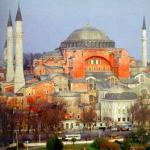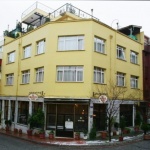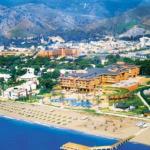Sights Istanbul, Turkey
 The former capital of three great empires - Roman, Byzantine and Ottoman - offers a fascinating mixture of past and present, old and new, modern and traditional. Istanbul has become one of the large and attractive museums in the world outdoors. Like Paris, Rome and London, he also called the "city - museum". Churches, palaces, museums, mosques and bazaars, as well as natural attractions seem to be eternal.
The former capital of three great empires - Roman, Byzantine and Ottoman - offers a fascinating mixture of past and present, old and new, modern and traditional. Istanbul has become one of the large and attractive museums in the world outdoors. Like Paris, Rome and London, he also called the "city - museum". Churches, palaces, museums, mosques and bazaars, as well as natural attractions seem to be eternal.One of the most remarkable creations of the Byzantine world and the architecture is the Cathedral of St. Sophia. It was built in the second half of VI century. Above the creation of such talented architects worked as Isidore of Miletus and Anfimov of Thrall. The Cathedral was completed in the style tri-domed basilica. The dome has a very large size: a diameter of 33 meters and a height of 55 meters above the floor level. On both sides of the dome to join two large polukupola. Before entering the temple is a large courtyard. If you enter into the temple, you'll see an extraordinary beautiful sight: you see the concave surface of the arches and polukupola who aspire to the main dome. All of this is decorated with gold mosaics, in contact with which the sun's rays shimmer with rainbow colors. At the end of XI century, the Emperor Comnenus Alex said that, in the Cathedral of St. Sophia is a huge number of diverse wealth, which exceeds the total wealth of all the other temples of the city together.
After the conquest of Constantinople in 1453, the Cathedral of St. Sophia, Muslims turned into a mosque and gradually adapted it to their religion. This lasted until 1935, when the mosque ceased to be used for its intended purpose, and it became a museum. St. Sofia Cathedral is one of the most prominent representatives of Byzantine architecture. This construction is not just inspired artists for creation of various masterpieces.
Mosque of Ahmed.
In the first half of XVII century, directly opposite the church of Hagia Sophia was built mosque, Ahmed, is also known under the name Blue Mosque. It was done on the project's own architect of Sultan Ahmed I, whose name was Sedefkarom Mehmed. Distinctive feature of the mosque was a huge dome, which reached a diameter of more than 23 meters, and to him adjoined another 4 polukupola. In the mosque, there are 6 minarets and has 260 windows, which are decorated with colorful stained glass. Light penetrating through those windows, creates a unique beauty and grandeur of the spectacle.
After many centuries, even today, remains a secret history of the city. For example, Pliny the Elder believed that the first people that settled in this city, appeared in the village, nosivshem name Ligos. Scientists, in turn, believe that Byzantium was merely another city and is located on the shores of the Bosphorus. The date of foundation of the city they consider to be 660 BC City with its very inception was to develop successfully, especially to that he has all the necessary prerequisites. Byzantium was located at the intersection of important trade routes. Because of this, he had a great opportunity to take charge of all by passing ships. Therefore, this feature has played a significant role in the development and prosperity of the city. In 73, the city became part of the Roman province of Bithynia and Pontus. In the year 196 as a result of prolonged fighting of the city ceased to exist in their original meaning, and its territory was significantly reduced. Savior for the city was Aurelius Antonio Caracalla. He began to recover the lost city of splendor and luxury. He began to rebuild what was destroyed and destroyed as a result of a prolonged struggle. He even succeeded in extending the city. As a result, the city began to carry the name of Antonio, but for it he managed to survive for only about one century.
Topkapi Palace is one of the major sights of Istanbul and is one of the most visited museums in Turkey. For 400 years the palace was the center of control of the Ottoman State, one of the three major empires of the world.
One of the tourist centers of Istanbul is the "Area Ahmed" (formerly known as "Hippodrome"). Ancient monuments in the center and around this area are the most important sights of Istanbul. In 203, the future Emperor Caracalla laid in the west of the city a huge hippodrome, housed 100,000 spectators. Construction was completed in May of 330 years in the reign of Byzantine Emperor Constantine. In the Byzantine period racecourse served as the venue for sports and cultural activities. The most common and gambling spectacle of that period were horse racing. At the racetrack arranged fights gladiators and presentation of memes. Hippodrome served as an arena of political debate and, finally, in the Byzantine period it was turned into "open air museum. On the walls and in the heart of the Hippodrome, exhibited columns, sculpted monuments, sundials, obelisks and monuments brought here from all over the world.
Egyptian obelisk
The famous Egyptian obelisk of Thutmose III, whose age is 4,5 thousand years, in the year 330 brought to the city of Constantine the Great. Almost 60 years he could not find a decent place, and all this time he was lying on the ground until it was installed by Emperor Theodosius I on the racetrack.
The Egyptian obelisk is the most ancient monument of antiquity not only the racetrack, but also in Istanbul. Pharaoh built it in honor of the triumph of Mesopotamia. In Egypt and in cities across Europe have copies of the obelisk.
Süleymaniye Mosque was built by architect Sinan on the order of 10 - the first sultan of the Ottoman Sultan Suleyman the Lawgiver, who reigned between 1520-1566 gg. Construction of the mosque, begun in 1550, was completed in 1557. During the reign of Sultan Suleyman the Lawgiver, Ottoman Empire was at its zenith, and reach the peak, which reached the Byzantine Empire in the years of Justinian. Architect Sinan mosque went down in history as "the architect, who does not need an architectural plan.
Erebatan-shed. Translated into Russian means "a failed underground palace". Its arches form a large area: 70 meters in width and 140 meters in length. These ancient structures were prostroeny for cooling water. For these purposes, used by marble columns, and almost to the top, they were placed under water. In the role of the pedestals were the head of Medusa. But since the Turkish residents prefer running water, the water from existing reservoirs are not used for their needs. So many reservoirs of water pumped, and they have been redeveloped in the markets. Subsequently, for Erebatan-shed not followed properly and quickly abandoned it altogether. Later there appeared fish, and locals even tried to engage in these latter-day field of fisheries. In the 80 years of XX century reservoir finally lost its intended purpose and has become a regular sight, which attracts the attention of visiting tourists.


